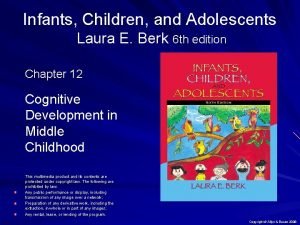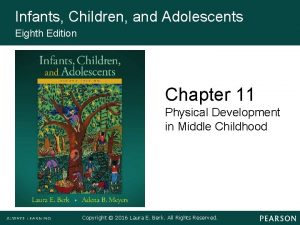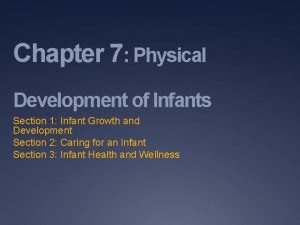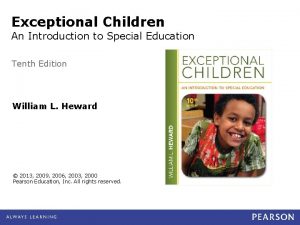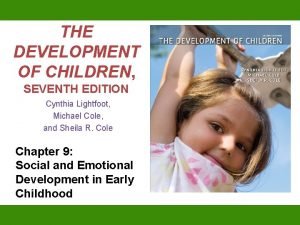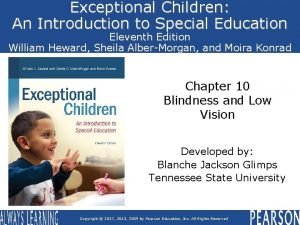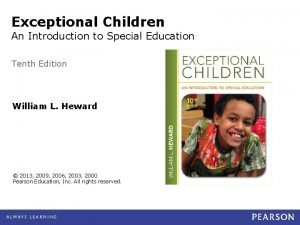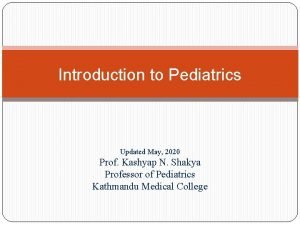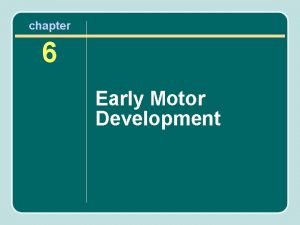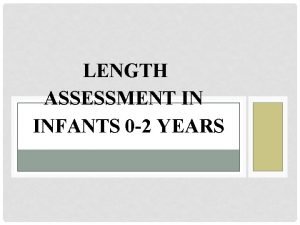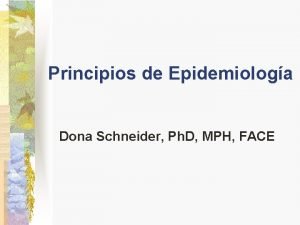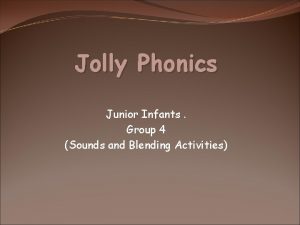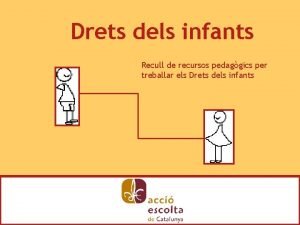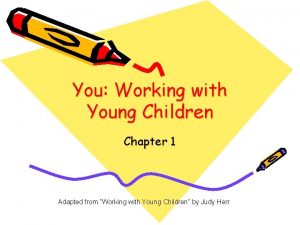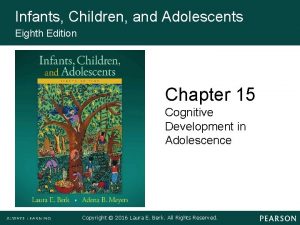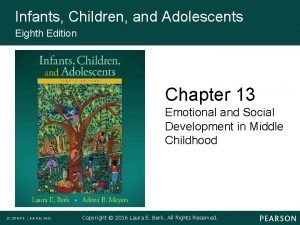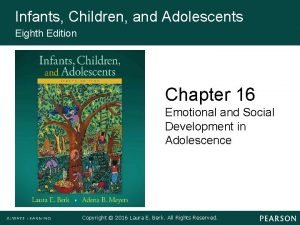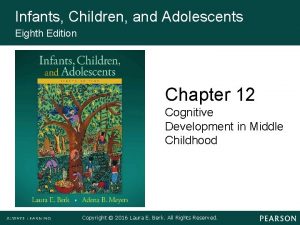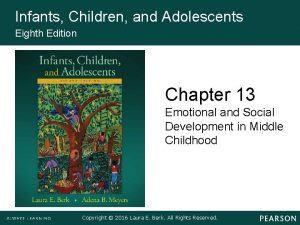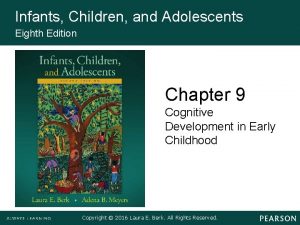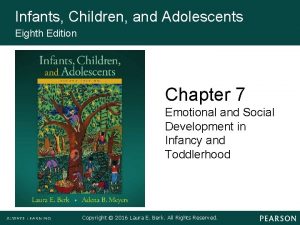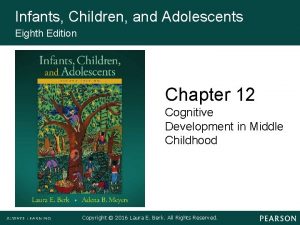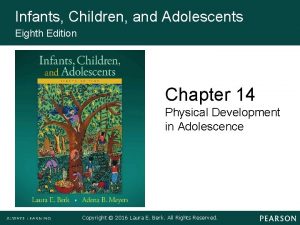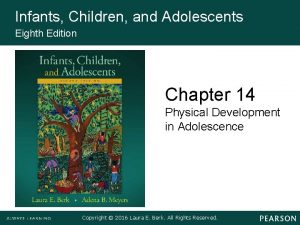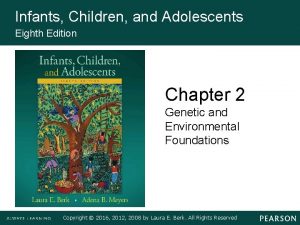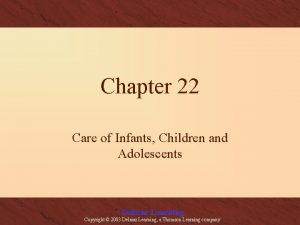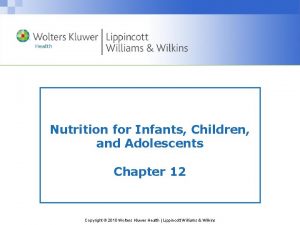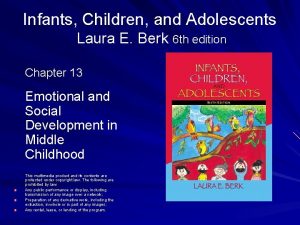Infants Children and Adolescents Eighth Edition Chapter 4









































- Slides: 41

Infants, Children, and Adolescents Eighth Edition Chapter 4 Birth and the Newborn Baby Copyright © 2016 Laura E. Berk. All Rights Reserved

Learning Objectives (1 of 2) Birth/Newborn • • • 1. Describe three stages of childbirth, the baby’s adaptation to labor and delivery, and the newborn baby’s appearance. 2. List common medical interventions during childbirth, circumstances that justify their use, and any dangers associated with each. 3. What are the risks of oxygen deprivation, preterm birth, and low birth weight, and what factors can help infants who survive a traumatic birth? Copyright © 2016 Laura E. Berk. All Rights Reserved

Learning Objectives (2 of 2) • • • 4. Describe the newborn baby’s reflexes and states of arousal, including sleep characteristics and ways to soothe a crying baby. 6. Describe the newborn baby’s sensory capacities and close parent–infant contact shortly after birth. 7. Describe the usefulness of neonatal behavioral assessment. Copyright © 2016 Laura E. Berk. All Rights Reserved

The Three Stages of Labor Figure 4. 1 Copyright © 2016 Laura E. Berk. All Rights Reserved

The Apgar Scale Score Sign 0 1 2 Heart rate No heartbeat Respiratory effort Reflex irritability No breathing for 60 seconds No response Muscle tone Completely limp Color Blue body, arms, and legs Under 100 beats per minute Irregular, shallow breathing Weak reflexive response Weak movements of arms and legs Body pink with blue arms and legs 100 to 140 beats per minute Strong breathing and crying Strong reflexive response Strong movements of arms and legs Body, arms, and legs completely pink Copyright © 2016 Laura E. Berk. All Rights Reserved

The Apgar Scale (continued) • Score of 7 or better: good condition • Score between 4 and 6: baby needs assistance • Score of 3 or lower: baby is in serious danger and needs medical attention Copyright © 2016 Laura E. Berk. All Rights Reserved

Approaches to Childbirth Western society: • Before late 1800 s → home births • Post-industrial revolution → hospital births • 1950 s– 1960 s → movement toward natural childbirth • Today → birth centers (and some home births) Copyright © 2016 Laura E. Berk. All Rights Reserved

Elements of Natural, or Prepared, Childbirth • Classes • Relaxation and breathing techniques • Labor coach Copyright © 2016 Laura E. Berk. All Rights Reserved

Other Natural Childbirth Practices • Doula: a trained lay attendant who provides social support • Delivery positions – Upright: shortens labor and reduces complications – Water birth: relaxes mother, shortens labor, and reduces complications • Home delivery: less than 1% of U. S. births Copyright © 2016 Laura E. Berk. All Rights Reserved

Medical Interventions in Childbirth • Fetal monitoring • Medication – Analgesics – Anesthetics • Instrument delivery • Induced labor • Cesarean delivery Copyright © 2016 Laura E. Berk. All Rights Reserved

Instrument Delivery • Low forceps can injure the baby’ head and the mother’s tissues. • Vacuum extractors increase the risk of: – Bleeding between baby’s skin and skull – Bleeding beneath the baby’s skull – Infant seizures Copyright © 2016 Laura E. Berk. All Rights Reserved

Instrument Delivery Figure 4. 2 Copyright © 2016 Laura E. Berk. All Rights Reserved

Cesarean Delivery • Cesarean deliveries account for 37% of births in the United States. • Cesareans are warranted in medical emergencies such as – – Rh incompatibility. premature separation of the placenta from the uterus. infection. baby in breech position. • Many cesareans are unnecessarily performed. Copyright © 2016 Laura E. Berk. All Rights Reserved

Anoxia • Oxygen deprivation at birth • Can lead to brain damage or later cognitive, language problems – Cerebral palsy • Causes include: – Squeezing of umbilical cord – Placenta abruptio, placenta previa – Failing to breathe after birth Copyright © 2016 Laura E. Berk. All Rights Reserved

Preventing Brain Cell Death from Anoxia • Additional brain cell death can occur in the hours after birth. • Prevention strategies: – Head-cooling device: reduces brain damage and increases newborn behavioral assessment scores – Precooled water blanket: reduces death and disability rates in the first two years Copyright © 2016 Laura E. Berk. All Rights Reserved

Preterm and Small-for-Date Babies Preterm • Born weeks before their due date • May be appropriate weight for length of pregnancy Small-for-Date • May be born at due date or preterm • Below expected weight for length of pregnancy Copyright © 2016 Laura E. Berk. All Rights Reserved

Rates of Infant Survival and Disability by Length of Pregnancy Figure 4. 3 (Adapted from Bolisetty et al. , 2006. ) Copyright © 2016 Laura E. Berk. All Rights Reserved

Preterm Infants • 1 to 2 more weeks in the womb can contribute greatly to infant health. – Reduced rates of illness – Fewer costly medical procedures – Shorter hospital stays – More favorable physical and cognitive development Copyright © 2016 Laura E. Berk. All Rights Reserved

Interventions for Preterm Infants • Isolette • Respirator • Feeding tube • Intravenous medication • Special infant stimulation • Kangaroo care • Parent training in caregiving Copyright © 2016 Laura E. Berk. All Rights Reserved

Influence of Intensity of Early Intervention for Low-Income Preterm Babies on Intellectual Functioning at Age 8 Figure 4. 4 (Adapted from Hill, Brooks-Gunn, & Waldfogel, 2003. ) Copyright © 2016 Laura E. Berk. All Rights Reserved

Health Care for Parents and Newborn Babies Infant mortality: number of deaths in the first year of life per 1, 000 live births. In spite of technological advances, the United States has made little progress in reducing infant death rates. Neonatal mortality: number of deaths in the first month. • Low birth weight is the second highest contributor to infant mortality, which is largely preventable. Copyright © 2016 Laura E. Berk. All Rights Reserved

Infant Mortality Around the World Figure 4. 5 (Adapted from U. S. Census Bureau, 2014 a. ) Copyright © 2016 Laura E. Berk. All Rights Reserved

Birth Complications, Parenting and Resilience • Kauai study: If birth complications are not severe, a supportive home can restore children’s growth. • Some children with troubled home environments are able to overcome birth complications with outside support. Copyright © 2016 Laura E. Berk. All Rights Reserved

Precious Moments After Birth • Oxytocin causes the breasts to “let down” milk, heightens the mother’s responsiveness to baby • Fathers also show hormonal changes that are associated with positive emotional reactions to infants. • But a favorable parent–infant relationship does not depend on immediate bonding. Copyright © 2016 Laura E. Berk. All Rights Reserved

Newborn Reflexes • Eye blink • Rooting • Sucking • Swimming • Moro • Palmar grasp • Tonic neck • Stepping • Babinski Copyright © 2016 Laura E. Berk. All Rights Reserved

Adaptive Value of Newborn Reflexes • Survival • Evoking interaction from caregivers • Motor development Copyright © 2016 Laura E. Berk. All Rights Reserved

Infant States of Arousal • Regular (NREM) sleep • Irregular (REM) sleep • Drowsiness • Quiet alertness • Waking activity and crying Copyright © 2016 Laura E. Berk. All Rights Reserved

The Mysterious Tragedy of Sudden Infant Death Syndrome • SIDS is the leading cause of infant mortality between 1 week and 12 months in industrialized nations. • Its occurrence tends to peak between 2 and 4 months of age, when reflexes decline. Copyright © 2016 Laura E. Berk. All Rights Reserved

Reducing Incidence of SIDS • Quit smoking and taking drugs. • Put babies to sleep on their backs. • Remove soft bedding. • Pacifier use Copyright © 2016 Laura E. Berk. All Rights Reserved

Ways to Soothe a Crying Baby • Hold on shoulder and rock or walk • Swaddle • Pacifier • Talking or rhythmic sounds • Ride in carriage, car, swing • Massage • Combine methods Copyright © 2016 Laura E. Berk. All Rights Reserved

Newborn Sense of Touch Reflexive response to touch on mouth, palms, soles, genitals Sensitive to pain • Severe pain can disrupt child’s developing capacity to regulate stress. • Relieve pain with analgesics, sugar, breast milk, gentle holding. Copyright © 2016 Laura E. Berk. All Rights Reserved

Newborn Senses of Taste and Smell • Prefer sweet tastes at birth • Quickly learn to like new tastes • Display odor preferences from birth • Can locate odors and identify mother by smell from birth Copyright © 2016 Laura E. Berk. All Rights Reserved

Newborn Senses of Taste and Smell Figure 4. 6 (From B. Schaal, L. Marlier, & R. Soussignan, 2000, “Human Foetuses Learn Odours from Their Pregnant Mother’s Diet, ” Chemical Senses, 25, p. 731. Reprinted by permission of Oxford University Press, Inc. , and Benoist Schaal. ) Copyright © 2016 Laura E. Berk. All Rights Reserved

Newborn Sense of Hearing • Can hear a wide variety of sounds at birth • Prefer complex sounds to pure tones • Learn sound patterns within days • Sensitive to voices, and biologically prepared to learn language Copyright © 2016 Laura E. Berk. All Rights Reserved

Newborn Sense of Vision • Least developed of senses at birth • Unable to see long distances or focus clearly • Scans environment and tries to track interesting objects • Color vision becomes adultlike after 4 months. Copyright © 2016 Laura E. Berk. All Rights Reserved

Infant Vision vs. Adult Vision Figure 4. 7 (From Kellman & Arterberry 2006; Slater et al. , 2010. ) Copyright © 2016 Laura E. Berk. All Rights Reserved

Neonatal Behavioral Assessment • Neonatal Behavioral Assessment Scale (NBAS) evaluates a baby’s reflexes, muscle tone, state changes, and responsiveness to physical and social stimuli. • Neonatal Intensive Care Unit Network Neurobehavioral Scale (NNNS) is specially designed for use with newborns at risk for developmental problems. Copyright © 2016 Laura E. Berk. All Rights Reserved

Transition to Parenthood • Gender roles may become more traditional. • Sharing caregiving predicts greater happiness and sensitivity to the baby. • Postponing parenthood until the late twenties or thirties eases transition. Copyright © 2016 Laura E. Berk. All Rights Reserved

Single-Mother Families • 40% of U. S. births to single mothers • Most nonmarital births are unplanned. – Adolescents – Low-income women in 20 s – Financially secure women ages 30– 45 are an exception. Copyright © 2016 Laura E. Berk. All Rights Reserved

Parental Depression and Child Development • 8 to 10% of mothers experience chronic depression. • 3 to 5% of fathers also report depression after the birth of a child. • Parental depression can have serious negative effects on all domains of child development. • Early treatment is vital. Copyright © 2016 Laura E. Berk. All Rights Reserved

Interventions for New Parents • Prebirth counseling can ease the transition to parenthood. • High-risk parents struggling with poverty or a baby with disabilities benefit from intensive intervention. • Low-income parents may require tangible support (food, money, transportation, affordable child care). Copyright © 2016 Laura E. Berk. All Rights Reserved
 Infants, children, and adolescents 8th edition
Infants, children, and adolescents 8th edition Infants, children, and adolescents 8th edition
Infants, children, and adolescents 8th edition Infants and children 8th edition
Infants and children 8th edition Infants and children 8th edition
Infants and children 8th edition Psychology eighth edition david g myers
Psychology eighth edition david g myers Psychology
Psychology Operations management eighth edition
Operations management eighth edition The fifth, sixth, seventh, and eighth amendments protect *
The fifth, sixth, seventh, and eighth amendments protect * Difference between courtship and dating
Difference between courtship and dating Chapter 9 intellectual development of infants
Chapter 9 intellectual development of infants Chapter 7 physical development of infants
Chapter 7 physical development of infants Anagram of eighth
Anagram of eighth Matching planet rings
Matching planet rings Quarter inch fraction
Quarter inch fraction What is the eighth commandment catholic
What is the eighth commandment catholic The eighth wonder
The eighth wonder Seven eighths crown
Seven eighths crown Eighth amendment excessive bail
Eighth amendment excessive bail Eighth letter of the alphabet
Eighth letter of the alphabet Eighth amendment excessive bail
Eighth amendment excessive bail Seventh amendment meaning
Seventh amendment meaning Exceptional children 10th edition
Exceptional children 10th edition The development of children 7th edition
The development of children 7th edition Gordon lightfoot ethnicity
Gordon lightfoot ethnicity Introduction of exceptional child
Introduction of exceptional child Exceptional children 10th edition
Exceptional children 10th edition Using mis (10th edition) 10th edition
Using mis (10th edition) 10th edition Chapter 1
Chapter 1 The creative curriculum for infants toddlers and twos
The creative curriculum for infants toddlers and twos Sign and symptoms of cystic fibrosis
Sign and symptoms of cystic fibrosis Infants age range
Infants age range Give me a dozen healthy infants
Give me a dozen healthy infants Sentinel injuries in infants are
Sentinel injuries in infants are Junior infants art ideas
Junior infants art ideas Infant personality development
Infant personality development Rate controllers motor development
Rate controllers motor development Length board for infants
Length board for infants Chrisomes infants
Chrisomes infants Jjjj song
Jjjj song Dinamiques per treballar els drets dels infants
Dinamiques per treballar els drets dels infants Five year old tammy mistakenly believes
Five year old tammy mistakenly believes Working with young children chapter 1
Working with young children chapter 1

